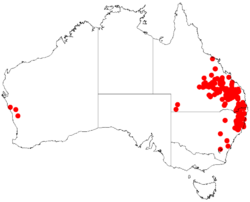Biology:Acacia blakei
| Blake's wattle | |
|---|---|
| Scientific classification | |
| Kingdom: | Plantae |
| Clade: | Tracheophytes |
| Clade: | Angiosperms |
| Clade: | Eudicots |
| Clade: | Rosids |
| Order: | Fabales |
| Family: | Fabaceae |
| Subfamily: | Caesalpinioideae |
| Clade: | Mimosoid clade |
| Genus: | Acacia |
| Species: | A. blakei
|
| Binomial name | |
| Acacia blakei Pedley
| |

| |
| Acacia blakei occurrence data from Australasian Virtual Herbarium[1] | |
Acacia blakei, commonly known as Blake's wattle or Wollomombi wattle,[2] is a shrub belonging to the genus Acacia and the subgenus Juliflorae that is native to north eastern Australia.
Description
The erect tree typically grows to a height of less than 15 m (49 ft) and has fissured grey coloured bark. It has light green to brown coloured branchlets that are angular toward the apices but otherwise terete that are sometimes pruinose or scurfy. Like most species of Acacia it has phyllodes rather than true leaves. The phyllodes are flat and falcate with an elliptic to narrowly elliptic shape and a length of 5 to 17 cm (2.0 to 6.7 in) and a width of 4 to 22 mm (0.16 to 0.87 in). They are thinly coriaceous and usually glabrous and have two or three conspicuous longitudinal nerves and two or three less prominent nerves separate to the base.[3] It blooms between August and November producing simple inflorescences that occur in groups of one to three in the axils. The cylindrical flower-heads are 2 to 6 cm (0.79 to 2.36 in) in length with yellow to pale yellow or cream-coloured flowers. After flowering straight to curved seed pods form that are more or less flat except over the seeds. The glabrous to sparsely hairy seed pods have a length of 3 to 10 cm (1.2 to 3.9 in) and a width of 2 to 4 mm (0.079 to 0.157 in) and have a firmly papery to thinly leathery texture and are smooth or wrinkled longitudinally.[2]
Taxonomy
There are two known subspecies:
- Acacia blakei Pedley subsp. blakei
- Acacia blakei subsp. diphylla (Tindale) Pedley[3]
The specific epithet honours the botanist Stanley T. Blake (1911–1973) who once worked for the Queensland Herbarium.[2]
Distribution
It is endemic to central and eastern parts of southern Queensland as far north as Emerald and the Blackdown Tableland extending south to north eastern parts of New South Wales to around the Coxs River and Lake Yarrunga to the south west of Sydney.[3] It is usually part of dry sclerophyll forest and woodland communities.[2]
See also
References
- ↑ DOI Details. doi:10.26197/5c0b1388984eb. https://doi.ala.org.au/doi/2a9fc98a-7e1a-4920-87d3-abc094b07201. Retrieved 8 December 2018.
- ↑ 2.0 2.1 2.2 2.3 "Acacia blakei Pedley". PlantNet. Royal Botanic Garden, Sydney. http://plantnet.rbgsyd.nsw.gov.au/cgi-bin/NSWfl.pl?page=nswfl&lvl=sp&name=Acacia~blakei. Retrieved 22 September 2019.
- ↑ 3.0 3.1 3.2 "Acacia blakei". WorldWideWattle. Western Australian Herbarium. http://worldwidewattle.com/speciesgallery/blakei.php. Retrieved 21 September 2019.
Wikidata ☰ Q15211586 entry
 |

